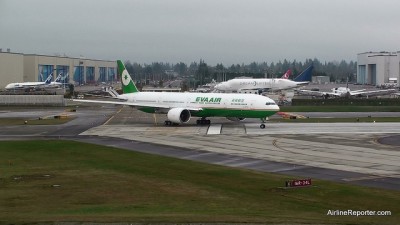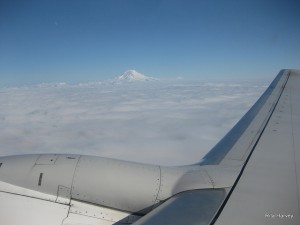
Eva Air Boeing 777-300ER (B-16715) about ready to take off from Paine Field on its delivery flight on Sunday.
Back in July I looked into why three brand new Eva Air Boeing 777’s were just sitting at Paine Field. It turned out they had issues with their Koito seats. Well, “issues” might be an understatement. Turns out not only were the seat’s safety in question, but also Koito’s certification process. So much so there was talk of an air worthiness directive from the FAA to ban the seats in the US.
Boeing and Eva Air has been silent with how these three Boeing 777’s were going to get seats. Last week the aircraft, which has been parked next to the Paine Field tower for months, were moved, prepped and started to take customer test flights (photo of B-16717). Then yesterday, the first of the three Boeing 777’s took its delivery flight to Taiwan (photo). Of course, the big question was what seats are inside the aircraft?
Eva Air obviously doesn’t want to say too much since I am guessing they will take legal action against Koito. Boeing has been staying pretty quiet as well, since they have a policy not to discuss their customers. However, I have been able to confirm that the seats in the aircraft are from Koito.
Beverly Holland with Boeing Communications explained to me that, “Koito Industries works directly with our airline customers. Ever since this issue came to our attention, we have been working closely with our customers who have purchased the seats to make sure the seats are fully compliant to Japan Civil Aviation Bureau (JCAB) and FAA regulations.”
As reported previously, if the JCAB certifies a seat, the FAA also certifies them through a US/Japan bilateral agreement. Boeing has had a team in Japan helping to make sure the seats are able to become certified. Holland did confirm, “Boeing is committed to helping our customers through this situation.”
Speaking with an Eva PR consultant Mary Graybill, she confirmed that the airline is working with Koito and Boeing to have the seats installed at Paine Field. She wasn’t able to confirm when the aircraft will officially be delivered, but did say that, “all three will be used to serve long-haul and regional routes, in rotation with the B777s EVA is already operating.” By chance of luck, I was at Paine Field on Sunday when I got an email alert stating a Boeing 777 filed a flight plan. Turned out to be one of the Eva Air Boeing 777’s (B-16715) being picked up by Eva pilots and flown to Taiwan. Due to heavy fog, the flight was delayed, but did take off at 2:35pm.
So are the seats safe in the Eva Boeing 777’s? Yes, I think so. Even though Boeing and Eva won’t talk much about what they have done, I would assume that neither would allow the airplanes to transport passengers if they haven’t verified the safety of the seats. It is great for Eva to make money using these Boeing 777’s, but it is disappointing they won’t be parked at Paine Field to spot anymore. At least Paine Field is quickly filling up with other Boeing airplanes to provide plenty of eye candy.
VIDEO OF EVA AIR BOEING 777-300ER (B-16715) on DELIVERY FLIGHT FROM PAINE FIELD taken from the Future of Flight’s Strato Deck
More:
* My photos from Eva Air Boeing 777 delivery flight
* Video from Liz Matzelle on the Boeing 777 taking off

A nice view of Mount Rainier.
Not that long ago I wrote a blog talking about Koito falsifying the safety of their seats and about three Eva Air Boeing 777’s sitting at Paine Field with no seats. Well, the story now gets better (or I guess worse).
Mary Kirby on FlightGlobal.com highlights the new issues facing the Koito seats. Due to Koito’s lack of following proper procedures 150,000 seats flown all over the world could have unknown safety issues and now the Federal Aviation Administration (FAA) and the European Aviation Safety Agency (EASA) have proposed airworthiness directives (AD) for the seats. The EASA proposal is a bit more strict than the FAA.
“The Japanese airworthiness authority (JCAB) has informed EASA that a review of the safety of passenger seats manufactured by Koito industries has disclosed discrepancies which include falsification of static, dynamic and flammability testing, as well as uncontrolled changes to production data (material and dimensional),” says EASA in its proposed AD.
“In addition JCAB confirmed that Koito records, showing evidence of falsification, could not be deemed complete. Examples include: fictitious dynamic test pulse plots inserted into test reports following failure to meet required certification requirements; flammability test coupons not representative of production parts, for instance by use of alternative adhesive not specified on the approved drawing; and fictitious deformation values entered in test reports when values exceeded the maximum allowed.”
Because of all the issues, the EASA has asked airlines to remove all Koito seats with-in the next two years. However, if additional testing shows the seats are safe, this could be changed to ten years. The FAA’s proposal puts it onto the airlines to test the seat’s safety. If airlines determine the seats are unsafe, they must be removed.
“Because this proposed AD will not require full compliance with every applicable regulation, seats on which the requirements of this proposed AD are completed successfully and are permitted to remain in service are limited in how they can be used. That is, unless they are shown to fully comply with the regulatory requirements, this proposed AD would restrict the installation of such seats and would require specific marking. These seats can be used as a direct spare for the same part number seat. However, any other use of such seats would be considered a new installation approval and would be required to comply with all regulations. Thus, seats not meeting all regulations could not be installed except as noted above, and if removed from an approved arrangement, would have to be destroyed or rendered unusable in some other manner acceptable to the FAA,” says the agency in its proposed AD.
The FAA estimated that its directive would affect 40,365 seats on 278 airplanes in the US with a total estimated cost of $875,000. However, I assume that the cost would be much higher than that.
Flight Global asked the FAA if they are concerned that unfavorable comparisons will be made about the their AD versus the EASA’s. An FAA spokesman explained, “Clearly the FAA doesn’t operate in a vacuum, but that said what we have to do is look at the safety impact and the safety issue and the proposed solution based on our environment, not the environment that exists in Europe.”
Most of the Koito seats flying in the US are on Continental Airlines aircraft. It looks like they anticipated this direction and have already started testing. “We’ve been working closely with the FAA over the past year in anticipation of the proposed rulemaking and have completed initial testing on the majority of our aircraft,” Julie King with Continental Public Relations explained to me via an email.
I started looking into this story because of the three Eva Air Boeing 777’s sitting at Paine Field, so I wanted to check in with them to see their status. They are still sticking with the, “no comment,” stance, which again, is not surprising.
So, what does this mean to you? Not too much, unless it turns out these seats are unsafe you end up sitting in one during an incident. However, as explained earlier, the chances of being in any airline seat during an accident, is very rare, being in a Koito seat is even less likely.

